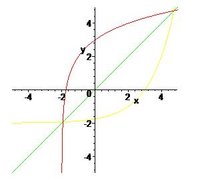… My daughter just [wants] to know if her answer is correct? …
Hi Philosophia. We can't be certain what she was asked to do, without seeing the exercise statement. However, I've looked at the work, and it seems mostly correct. Here are some issues.
The input/output chart for f
-1(x) shows the input -1.875 written as -1.88 (don't round it; write the exact value -1.875).
The same chart has the outputs mislabeled as f(x). The label should be f
-1(x) (because those inputs/outputs are for the inverse function).
Your daughter correctly wrote the asymptote for f(x). It is the horizontal line y = -2. Was she asked to also write the asymptote for the inverse function? (I don't see it.)
Overall, the work looks good, but please include the given instructions/questions next time. Cheers
PS: I would call this Intermediate Algebra. Some schools might call it Precalculus, but it's still algebra.
?

